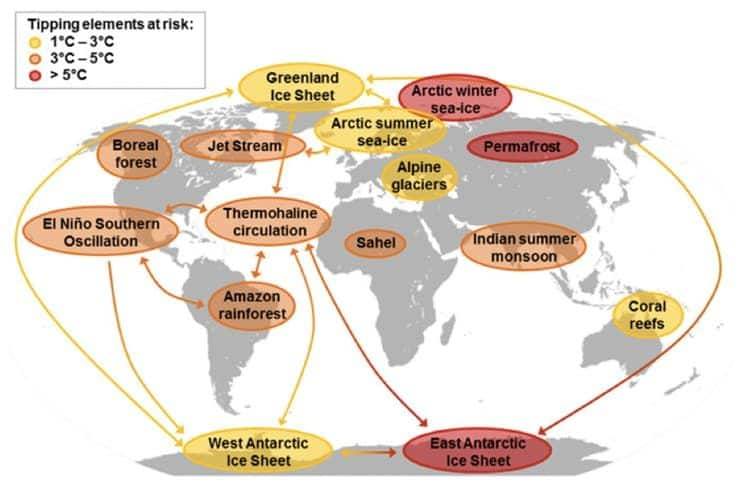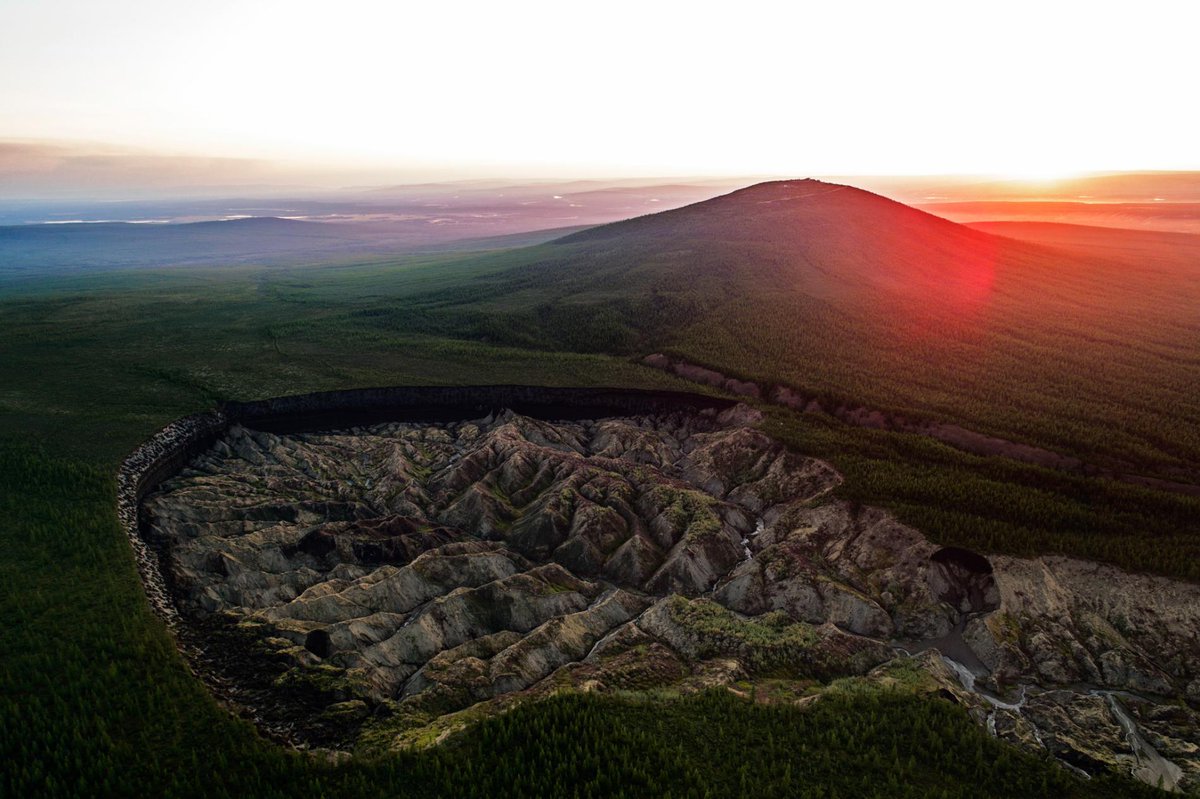Thursday August 16th… Dear Diary. The main purpose of this ongoing post will be to track United States extreme or record temperatures related to climate change. Any reports I see of ETs will be listed below the main topic of the day. I’ll refer to extreme or record temperatures as ETs (not extraterrestrials)😊. Here is today’s main climate change related topic:
Tipping Point Discussion…Part 7) Permafrost
Every time the subject of methane pops up in the climate world scientists bristle, emphasizing that carbon pollution is and will be a far greater factor for warming the planet’s temperature. We see many posts and articles saying that as permafrost melts great quantities of trapped methane (or natural gas) will be released into the atmosphere. Could a cascade effect occur producing a runaway greenhouse effect, cooking and dooming humanity? So what is the truth here? For this post I’ll try to present a little more clarity in association with the tipping point of permafrost. By no means is this issue scientifically settled as of this writing.
For reference here is that global tipping point chart by Dr. Steffen indicating roughly at what global average temperature above preindustrial conditions cooling factors helping to regulate the climate become warming, thus spiking surface temperatures higher even if CO2 pollution ceased:

(Global map by Will Steffen of potential tipping cascades. The individual tipping elements are color- coded according to estimated thresholds in global average surface temperature (tipping points) (12, 34). Arrows show the potential interactions among the tipping elements based on expert elicitation that could generate cascades. Note that, although the risk for tipping (loss of) the East Antarctic Ice Sheet is proposed at >5 °C, some marine-based sectors in East Antarctica may be vulnerable at lower temperatures.) From: http://www.pnas.org/content/early/2018/08/07/1810141115#ref-12
It’s surprising to me that global warming would have to get to +5C above preindustrial conditions according to Steffen’s team in order for enough permafrost to melt so that the climate tips towards warmth even if no more fossil fuel carbon was released into the atmosphere by that time, which should be avoided if the Paris Accords are adhered to. Permafrost is melting now at around +1C and should melt at an accelerated state as we approach +2C by the year 2030. Steffen evidently and scientifically considers trapped methane and carbon under permafrost to be low on the proverbial tipping point totem pole for exacerbated warming. To put it another way global averages would have to soar to at least +5C above preindustrial conditions before their should be great concern for melting permafrost to tip towards additional warming.
Other earlier studies put methane due to melting permafrost at a much lower tipping point threshold:
http://www.climatecentral.org/news/nearing-a-tipping-point-on-melting-permafrost-15636
Quoting from this article:
According to a paper published Thursday in Science, that melting could come sooner, and be more widespread, than experts previously believed. If global average temperature were to rise 2.5°F (1.5°C) above where it stood in pre-industrial times say earth scientist Anton Vaks of Oxford University and an international team of collaborators (and it’s already more than halfway there), permafrost across much of northern Canada and Siberia could start to weaken and decay. And since climate scientists project at least that much warming by the middle of the 21st century, global warming could begin to accelerate as a result, in what’s known as a feedback mechanism.
Arctic permafrost seen from a helicopter.
Credit: Brocken Inaglory via Wikimedia Commons
How much this will affect global temperatures, which are currently projected to rise as much as 9°F by 2100, is impossible to say. It all depends on how quickly the permafrost melts, and how quickly bacteria convert the plant material into carbon dioxide and methane gas, and nobody knows the full answer to that. But since climate scientists already expect a wide range of negative consequences from rising temperatures, including higher sea level, more weather extremes and increasing risks to human health, anything that accelerates warming is a concern.
Let’s present more science here from this Guardian article: https://www.theguardian.com/environment/climate-consensus-97-per-cent/2015/oct/13/methane-release-from-melting-permafrost-could-trigger-dangerous-global-warming
While methane is not currently as important as carbon dioxide, it has a hidden danger. Molecule for molecule, methane traps more heat than carbon dioxide; approximately 30 times more, depending on the time frame under consideration. However, because methane is present in much smaller concentrations (compared to carbon dioxide), its aggregate effect is less.
But what has scientists focusing on methane is the way it is released into the atmosphere. Unlike carbon dioxide, which is emitted primarily through burning of fossil fuels, methane has a large natural emission component. This natural emission is from warming permafrost in the northern latitudes. Permafrost is permanently frozen ground. Much of the permafrost is undisturbed by bacterial decomposition.
As the Earth warms, and the Arctic warms especially fast, the permafrost melts and soil decomposition accelerates. Consequently, an initial warming leads to more emission, leading to more warming and more emission. It is a vicious cycle and there may be a tipping point where this self-reinforcing cycle takes over.
Recently, a policy briefing from the world-leading Woods Hole Research Center has moved our understanding of this risk further through a clearly-written summary. The briefing cites two recent papers (here and here) that study the so-called permafrost carbon feedback.
One of these studies makes use of projections from the most recent IPCC report to estimate that up to 205 gigatons equivalent of carbon dioxide could be released due to melting permafrost. This would cause up to 0.5°C (up to 0.9°F) extra warming. Just as bad, the permafrost melting would continue after 2100 which would lock us into even more warming. Under this scenario, meeting a 2°C limit would be harder than anticipated. The current IPCC targets do not adequately account for this feedback.
To put this in perspective, permafrost contains almost twice as much carbon as is present in the atmosphere. In the rapidly warming Arctic (warming twice as fast as the globe as a whole), the upper layers of this frozen soil begin to thaw, allowing deposited organic material to decompose. The plant material, which has accumulated over thousands of years, is concentrated in to upper layers (half of it is in the top 10 feet). There is a network of monitoring stations that are measuring ground temperatures have detected a significant heating trend over the past few decades and so has the active layer thickness.
I communicated with Woods Hole expert Robert Max Holmes, who told me,
It’s essential that policymakers begin to seriously consider the possibility of a substantial permafrost carbon feedback to global warming. If they don’t, I suspect that down the road we’ll all be looking at the 2°C threshold in our rear-view mirror.
Just this week we see bad, new signs of thawing permafrost:
 Allan Margolin @AllanMargolin
Allan Margolin @AllanMargolin
@Brimshack @AlaskanNovelist @waltb31 @Eykis @KassandraSeven @jrzgrlz @2021_free @bjcreigh @FeistyLibLady @KayKosmos @climateguyw @PaulHBeckwith @citizensclimate

Well, from all I have read we need to err on the side of caution. Let’s stridently try to hold global averages below +2C below preindustrial conditions lest the methane spigot valves turn, unleashing more heat than the environment and us poor humans can take.
……………………………………………………………………………………
On Friday we won’t see any unusual extreme temperatures for mid August:

(As usual, this will be a fluid post in which more information gets added during the day as it crosses my radar, crediting all who have put it on-line.)
(If you like these posts and my work please contribute via the PayPal widget, which has recently been added to this site. Thanks in advance for any support.)
The Climate Guy
